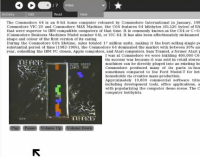The inspiration for this post comes from a talk by Alan Kay, entitled Beyond the Printing Press: Computers as Learning Environments for All Children. You can view the video recording of the talk here.

The Read activity of the future
The development versions of Read Activity is now shipping with Epub support. This makes me excited for quite a few reason. Of course, the most obvious reason to get excited is the fast growth and adoption of Epub as a standard for e-books. However, there is more to it...
Books, once again (after Gutenberg's time) are changing. Gutenberg brought in the transition from hand-written books to large-scale print - and now we see yet another shift, where books are transitioning from ink, paper and the printing press to bits stored inside a variety of devices. Towards the beginning of the printing press revolution, there was a strong desire and tendency to mimic the "old" format as much as possible, in terms of look and feel. Gutenberg and his associates even hand-drew illuminated decoration on the Gutenberg Bibles, to retain the similarity to the older, handwritten copies of the Bible. In what seems to be an almost eerie repetition, today, in the ebook, we see a strong desire to mimic the traditional book as much as possible. (eg ebook readers trying to retain the older "UI" paradigm, efforts to make ebooks retain the formatting niceties of traditional books, etc). This is not unusual, or wrong. We are used to the traditional book, and it is important to make the path to transition as smooth as possible.
However, what makes me really excited at this stage is something else. It is the potential new things we could do with Ebooks, things that would not have been possible with books in the old format. This weekend, I did some changes to a Epub file, and extended the Read Activity a bit to come up with a few such things:
- Audio-visual content inside books: This is almost obvious - with the transition to books which are read on devices having audio/video capabilities, the next logical step is to embed these into books. (Editor's note: You need a HTML 5 capable browser such as Firefox 3.5 to see the embedded videos.)
(Video from the Internet Archive, text from Wikipedia) - An interactive shell inside a book: An interactive Python shell inside a book teaching Python, so that small examples and snippets can be tried out inside the book, right away.
(Text from How to Think like a Computer Scientist, Python edition) - A full blown, interactive environment inside books: A book on digital logic can have a small sandboxing area, where readers could connect the various virtual components together, and see what happens.
(Text from Wikipedia and the Lorem Ipsum generator, demo from the Etoys project)
Of course, this is just a proof of concept, and probably most Epub readers will simply ignore the interactive content part. Moreover, there may be security issues with such books as well (the idea of having a Python shell inside a book will make many nervous) - but I think this is where Bitfrost, and its software implementation, Rainbow (which is essentially an isolation shell) comes in.
There is another way of "interaction" which I have not covered in the above screencasts - and this is something which is already available in traditional ink and paper books, especially text-books. Ebooks need to support "exercises" like fill-in-the-blanks, multiple-choice-questions, etc. There is an urgent need to support this, and this should be done in a standardized way. The local storage standard associated with HTML5 seems to be a possible way forward, though probably there might be better ways to do this (especially if we want the ability to have teachers remotely check and evaluate exercises done on e-textbooks).
Sayamindu Dasgupta originally wrote this entry for his blog and he kindly allowed us to republish it here.

